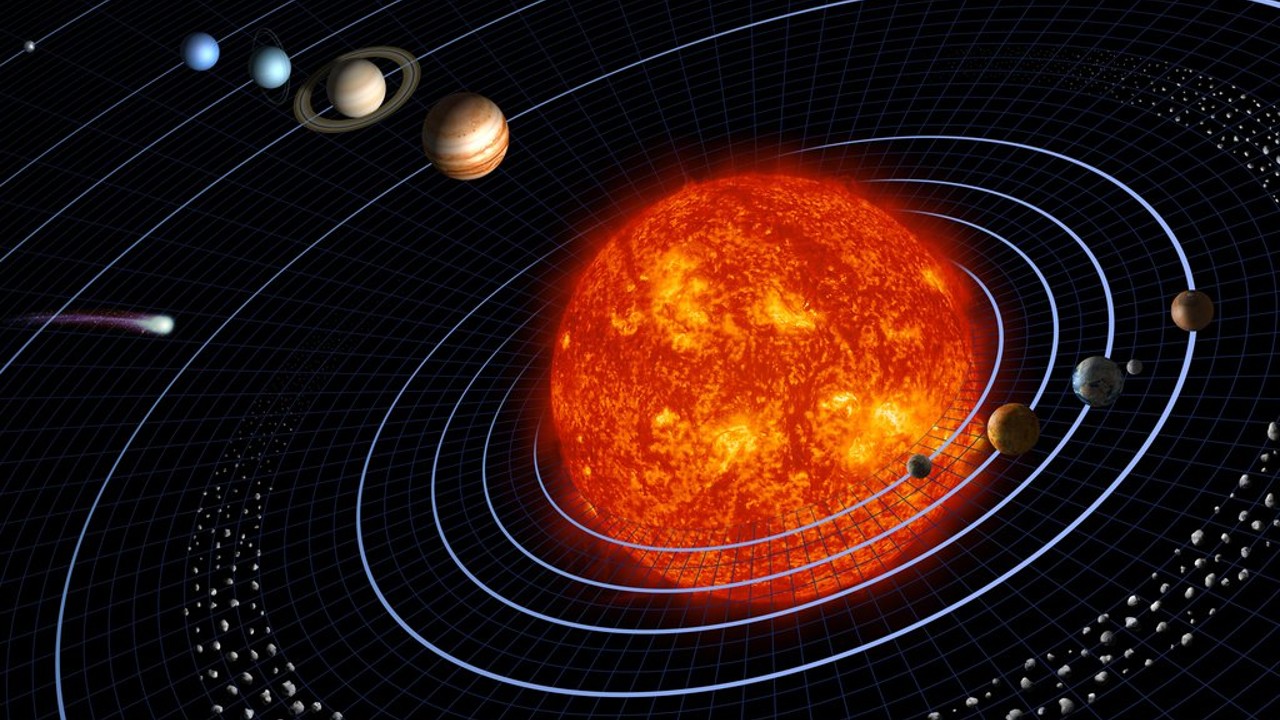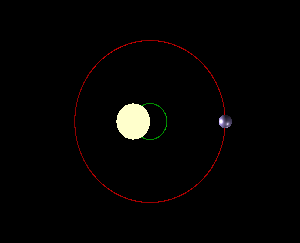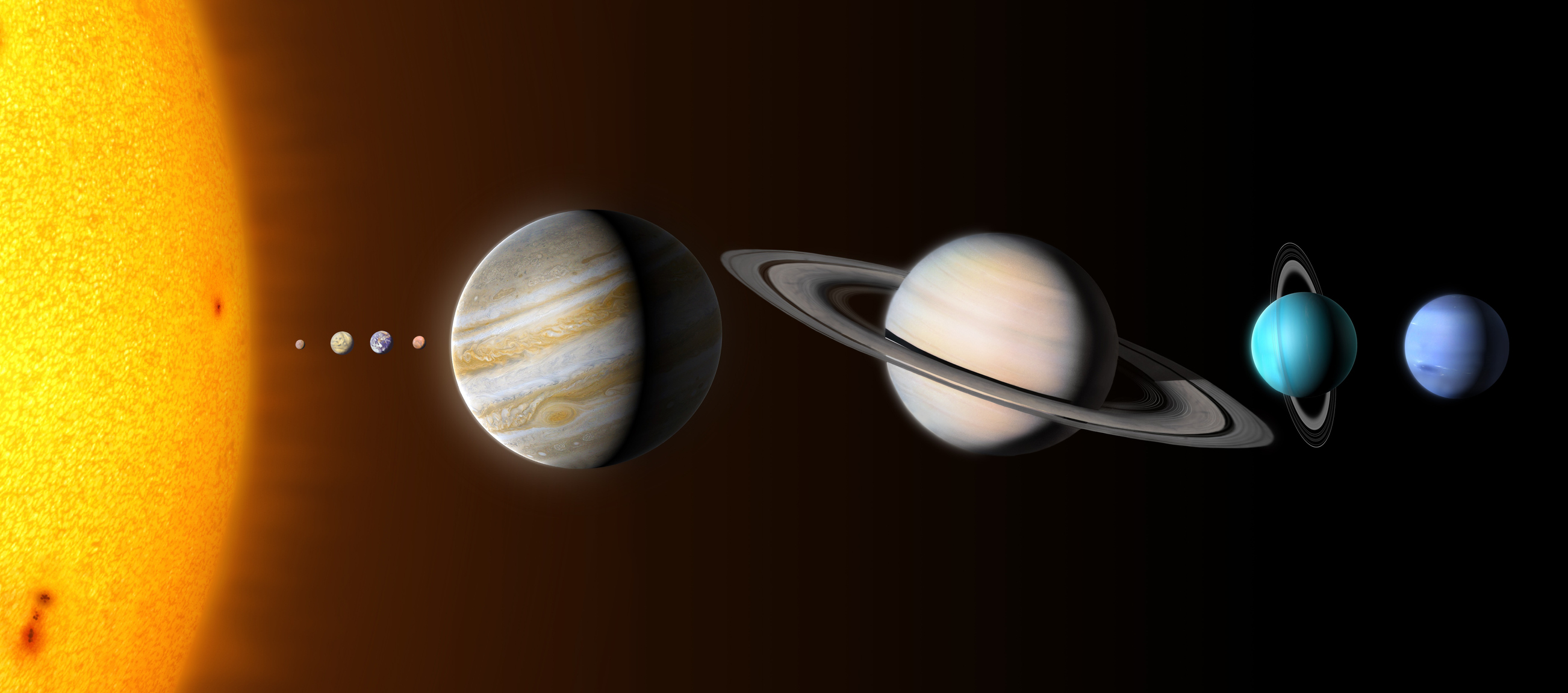Does the sun move in the solar system?
Yes and no.


From an early age, we are taught to understand that the planets of our solar system change in position while orbiting a central star, the sun. But does the sun itself move within the solar system?
Well, in general the sun is far from static in the universe. We know, for instance, that our star orbits the heart of the Milky Way at staggering speeds reaching 450,000 miles per hour (720,000 kilometers per hour) and dragging the whole solar system along with it.
Over the course of the day, the sun certainly appears to move from our vantage point, too. It crosses across the sky over Earth, giving us lovely sunrises and sunsets. This movement, however, is a result of the Earth rotating; it's not the result of the actual motion of the sun.
Related: Space mysteries: Why do Earth's magnetic poles flip?
Further, during the course of an Earth year, a familiar 365.3 days, the sun's position changes in the sky from our perspective as well. Still, according to Royal Museums Greenwich, that is not the result of the sun actually moving, but rather the result of Earth's tilt, or the fact that our planet has a flattened or "elliptical orbit" and is therefore sometimes closer to the sun during a year than at other times.
The time it takes a planet to complete a full orbit of the sun determines the length of its year, with the shortest year being that of the closest planet to the sun, Mercury. Mercury's year is equivalent to 88 Earth days. The longest planetary orbit in our cosmic neighborhood belongs to Neptune, which has a year that lasts 60,182 Earth days (164.8 Earth years).
But returning to our main question, the short answer is that the sun does indeed shift position within the solar system, albeit by a tiny amount. That limited oscillating motion or "wobble" results from the gravitational influences of the planets that orbit the sun.
Get the Space.com Newsletter
Breaking space news, the latest updates on rocket launches, skywatching events and more!
Patrick Antolin is a solar scientist at Northumbria University who specializes in phenomena that we observe in the solar atmosphere, and in particular, the solar corona, which is the most extended layer of the sun's atmosphere.
"Movement is always relative to the frame of reference. The solar system orbits around the center of the Milky Way — our galaxy — but even within the frame of the solar system, the sun is not exactly static because of the gravitational interaction with the other bodies in the system," Antolin told Space.com.
The solar scientist said that the gravitational interaction between two bodies is a two-way street. As body one pulls on body two, body one is also being pulled on itself, even if the size difference between the two bodies is immense, as is the case with the sun and the planets of the solar system.
"Because of the large difference in mass between the sun and any other body in the solar system, the sun is the main gravitational attractor and is not very much affected by any of the other planets' gravity," he continued.

The net result of all this is that the planets of the solar system don't technically orbit their star. Instead, the sun and each planet orbit a point of mutual gravity called a "barycenter," the location of which is determined by the masses of the bodies in question.
Because the sun is so much more massive than the planets, these barycenters are located deep within the sun; if a planet's mass is small, the barycenter it orbits falls closer to the sun's heart. And the closer these barycenters are to the sun's center, the less the sun will wobble due to orbiting it.
"To a good approximation, one can neglect the small gravitational pull from any other planet," Antolin said. "However, our instruments and theory are precise and advanced enough that we can detect the small deviations from these additional gravitational pulls that the other bodies exert on the sun, and in particular that produced by Jupiter, which is more massive than all the other solar system planets combined."
The sun is around 1,000 times more massive than Jupiter, which is the fifth planet in the solar system, so the effect on the sun as a result of the gas giant is no more than a 40-mile-per-hour "wobble" over the planet’s 12-Earth year-long orbit around its star, according to Lick Observatory.

Stellar wobbles caused by orbiting planets are detectable by the shift in the wavelength of light they produce, similar to the Doppler shift. This means the Doppler effect can be used to detect planets orbiting stars outside the solar system, called extrasolar planets or "exoplanets." As a star wobbles, the wavelength of its light is stretched and becomes redder as its motion is directed away from Earth, known as "redshift." As a star moves toward Earth, the wavelength of its light is compressed, making it relatively bluer in color, predictably referred to as "blueshift."
Not only can this effect be used to spot a stellar wobble and, therefore, detect the presence of an exoplanet, but it can also be used to measure some of the properties of the bodies in distant planetary systems.
"If one can detect the wobble as well as the speeds of the bodies, then one can infer the masses and distances between each other," Antolin said. "This can be applied to any star system in which we can detect the wobble and measure the speeds of the rotating bodies.
"Of course, there is additional complexity when more than two massive bodies are involved, but numerical models can often help find out the most likely number of planets involved in the wobble."
Join our Space Forums to keep talking space on the latest missions, night sky and more! And if you have a news tip, correction or comment, let us know at: community@space.com.

Robert Lea is a science journalist in the U.K. whose articles have been published in Physics World, New Scientist, Astronomy Magazine, All About Space, Newsweek and ZME Science. He also writes about science communication for Elsevier and the European Journal of Physics. Rob holds a bachelor of science degree in physics and astronomy from the U.K.’s Open University. Follow him on Twitter @sciencef1rst.
-
Helio When astronomers use the word "tiny", like "inconceivable" "it may not mean what you think it means." ;)Reply
As Wiki notes, the Sun can move, at most, just over 810,000 km, a little more than its radius and about 65x that of Earth.
"To calculate the actual motion of the Sun, only the motions of the four giant planets (Jupiter, Saturn, Uranus, Neptune) need to be considered. The contributions of all other planets, dwarf planets, etc. are negligible. If the four giant planets were on a straight line on the same side of the Sun, the combined center of mass would lie at about 1.17 solar radii, or just over 810,000 km, above the Sun's surface." -
arturo.v.dominguez@gmail. Reply
IMO, I believe the answer is yes. In addition to outside influences gravitational and/or inertial pull from whatever outside source we may want to associate it's motion/travel to. I do not believe it's own expansion and contraction cycles are geometrical static even if miniscule in their result.Admin said:We know the sun is currently zooming through space, but does it move within our solar system?
Space mysteries: Does the sun move in the solar system? : Read more -
Torbjorn Larsson Notably "the astronomical GPS system" of pulsar arrays had to improve on the knowledge of the system barycenter in order to later make the discovery of the gravitational background.Reply
Astronomers Have Located The Centre of The Solar System to Within 100 Metres
This is where the team's software enters the picture. It's called BayesEphem, and it's designed to model and correct for those uncertainties in Solar System orbits most relevant to gravitational wave searches using pulsars - Jupiter in particular.
30 June 2020, MICHELLE STARR, ScienceAlert
When the team applied BayesEphem to the NANOGrav data, they were able to place a new upper limit on the gravitational wave background and detection statistics. And they were able to calculate a new, more precise location for the Solar System barycentre that, going forward, could enable much more accurate low-frequency gravitational wave detections. -
arturo.v.dominguez@gmail. Reply
Wait a minute are you trying to force me to commit harry carry (aka harakiri)??? don't say you're not because it certainly sounds, to me, like you telling me the sun is not the center of our solar system. What's next the earth is the center of the universe??? LOLTorbjorn Larsson said:Notably "the astronomical GPS system" of pulsar arrays had to improve on the knowledge of the system barycenter in order to later make the discovery of the gravitational background.
30 June 2020, MICHELLE STARR, ScienceAlert








